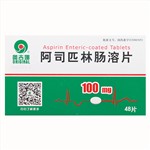阿司匹林对血小板聚集的抑制作用,因此阿司匹林肠溶片适应症如下:降低急性心肌梗死疑似患者的发病风险预防心肌梗死复发中风的二级预防降低短暂性脑缺血发作(TIA)及其继发脑卒中的风险降低稳定性和不稳定性心绞痛患者的发病风险动脉外科手术或介入手术后,如经皮冠脉腔内成形术(PTCA),冠状动脉旁路术(CABG),颈动脉内膜剥离术,动静脉分流术预防大手术后深静脉血栓和肺栓塞降低心血管危险因素者(冠心病家族史、
健客价: ¥17.8配合欧姆龙血糖仪一起使用测量血糖。
健客价: ¥59本品为非甾体抗炎药。临床可用于下列情况。1. 镇痛、解热:可缓解轻度或中度的疼痛,如头痛、牙痛、神经痛、肌肉痛及月经痛,也用于感冒和流感等退热。本品仅能缓解症状,不能治疗引起疼痛和发热的病因,故需同时应用其他药物对病因进行治疗。2. 抗炎、抗风湿:为治疗风湿热的常用药物,用药后可解热、使关节症状好转并使血沉下降,但不能去除风湿热的基本病理改变,也不能治疗和预防心脏损害及其他合并症。3.关节炎:除风
健客价: ¥3.5用于普通感冒或流行性感冒引起的发热,也用于缓解轻至中度疼痛如头痛、关节痛、偏头痛、牙痛、肌肉痛、神经痛、痛经。
健客价: ¥20调节“粘”热,镇静安神。用于“赫依”,“粘”热交争,山川间热,发烧,“赫依”引起的癫狂,昏迷,心神不安。
健客价: ¥36生精补髓,益气养血,强脑安神。用于肾精不足、气血两亏所致的头晕、乏力、健忘、失眠;神经衰弱症见上述证候者。
健客价: ¥19.5可作为全营养支持或部分营养补充,适用于成人及四岁或四岁以上的儿童.可口服或管饲.
健客价: ¥63应用其较强的免疫抑制作用,治疗各种变态反应性炎症、各种自身免疫性疾病。
健客价: ¥46.5镇惊,安神,行气。用于心慌气短,心神不安,气血淤滞,胸肋刺痛等。
健客价: ¥43生精补髓,益气养血,强脑安神。用于肾精不足、气血两亏所致的头晕、乏力、健忘、失眠;神经衰弱症见上述证候者。
健客价: ¥15用于治疗抑郁症。
健客价: ¥84补血滋阴,养心安神。用于阴血不足,失眠梦,心悸不宁,五心烦热,盗汗耳呜。
健客价: ¥6用于轻~中度急慢性溃疡性结肠炎的治疗。
健客价: ¥25胃食管反流性疾病(GERD) -糜烂性反流性食管炎的治疗 -已经治愈的食管炎患者防止复发的长期维持治疗 -胃食管反流性疾病(GERD)的症状控制 与适当的抗菌疗法联合用药根除幽门螺杆菌,并且 -愈合与幽门螺杆菌感染相关的十二指肠溃疡 -防止与幽门螺杆菌相关的消化性溃疡复发 需要持续NSAID治疗的患者 -与使用(非甾体抗炎药)NSAID治疗相关的胃溃疡治疗
健客价: ¥78补肝益肾,养血安神。用于肝肾不足所致头痛眩晕,心悸不宁,失眠多梦,健忘。
健客价: ¥11活血化瘀,活络通脉,改善脑梗塞、脑缺血功能障碍,恢复缺血性脑代谢异常,抗血小板聚集,防止脑血栓形成,改善微循环,降低全血粘度,增强颈动脉血流量,主要用于心脑血管栓塞性病症,主治中风、半身不遂、口舌歪斜、言语骞涩、偏身麻木。
健客价: ¥30.5用于支气管哮喘和喘息性支气管炎,以及其它呼吸系统疾病引起的咳嗽、咳痰、喘息等症状。
健客价: ¥40补肝益肾,养血安神。用于肝肾不足所致的头痛眩晕,心悸不宁,失眠多梦、健忘。
健客价: ¥17滋补强壮,镇静安神。用于神经衰弱,头痛,头晕,健忘失眠,耳鸣。
健客价: ¥15生精补髓,益气养血、强脑安神。用于肾精不足、气血两亏所致的头晕、乏力、健忘、失眠;神经衰弱症见上述证候者。
健客价: ¥13.5适用于支气管哮喘、喘息性慢性支气管炎及其它支气管痉挛引起的呼吸困难。
健客价: ¥18.5抑制下述情况时血小板粘附和聚集: 1.不稳定性心绞痛(冠状动脉血流障碍所致的心脏疼痛); 2.急性心肌梗塞; 3.预防心肌梗塞复发; 4.动脉血管的术后(动脉外科手术介入后如主动脉冠状动脉静脉搭桥术,PTCA); 5.预防大脑一过性的血流减少(TIA;短暂性脑缺血发作)和出现早期症状(如面部或手臂肌肉一过性瘫痪或一过性失明)后预防脑梗塞。
健客价: ¥10本品为非甾体抗炎药。临床可用于抗血栓:本品对血小板聚集有抑制作用,可防止血栓形成,临床用于预防一过性脑缺血发作、心肌梗死、心房颤动、人工心脏瓣膜、动静脉瘘或其他手术后的血栓形成。也可用于治疗不稳定型心绞痛。
健客价: ¥4养心安神,抑风。用于龙失调引起的风入命脉,神经官能症,神昏谵语,多梦,耳鸣,心悸颤抖,癫狂,哑结。
健客价: ¥19























